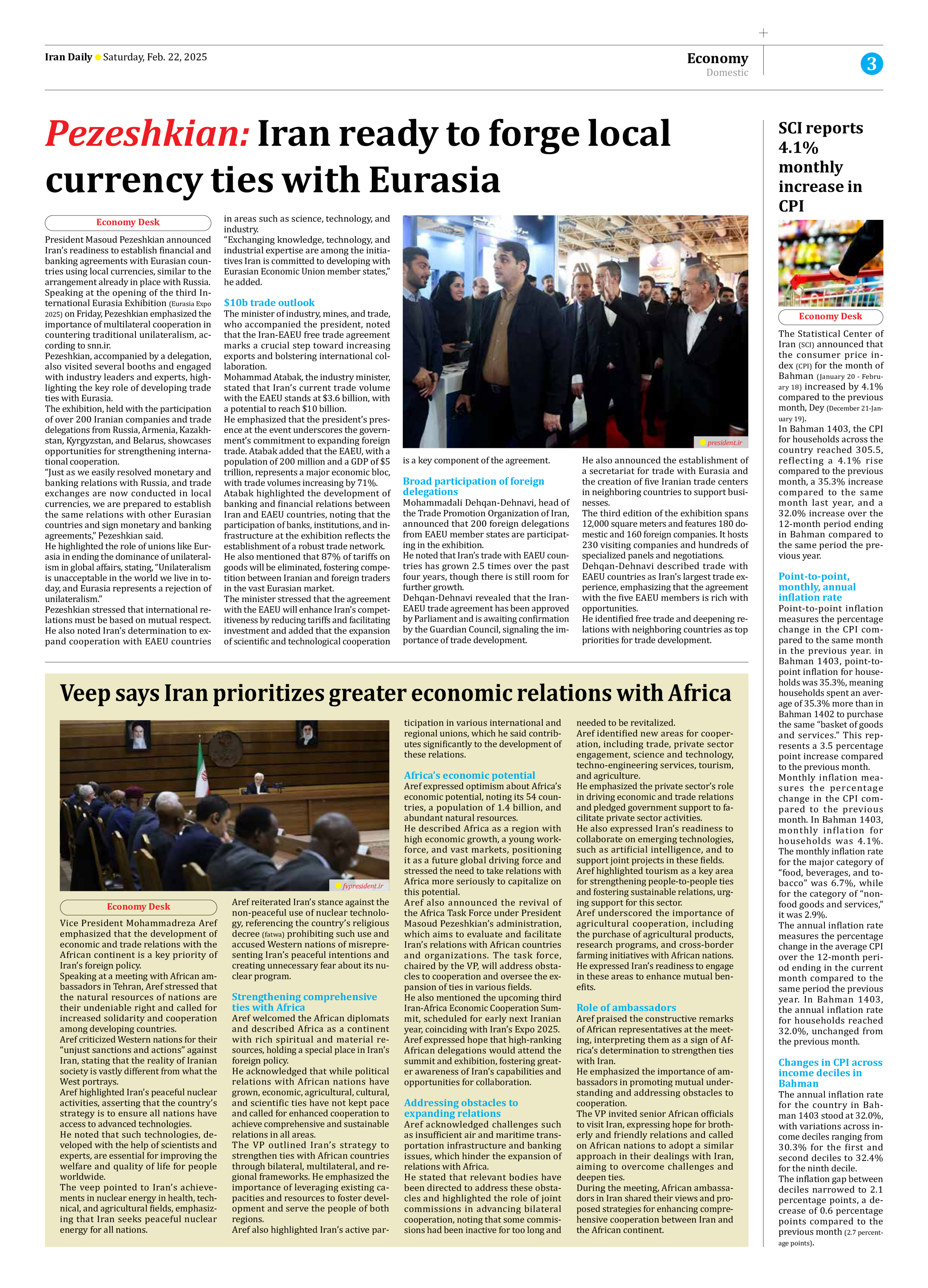
Pezeshkian: Iran ready to forge local currency ties with Eurasia
President Masoud Pezeshkian announced Iran’s readiness to establish financial and banking agreements with Eurasian countries using local currencies, similar to the arrangement already in place with Russia.
Speaking at the opening of the third International Eurasia Exhibition (Eurasia Expo 2025) on Friday, Pezeshkian emphasized the importance of multilateral cooperation in countering traditional unilateralism, according to snn.ir.
Pezeshkian, accompanied by a delegation, also visited several booths and engaged with industry leaders and experts, highlighting the key role of developing trade ties with Eurasia.
The exhibition, held with the participation of over 200 Iranian companies and trade delegations from Russia, Armenia, Kazakhstan, Kyrgyzstan, and Belarus, showcases opportunities for strengthening international cooperation.
“Just as we easily resolved monetary and banking relations with Russia, and trade exchanges are now conducted in local currencies, we are prepared to establish the same relations with other Eurasian countries and sign monetary and banking agreements,” Pezeshkian said.
He highlighted the role of unions like Eurasia in ending the dominance of unilateralism in global affairs, stating, “Unilateralism is unacceptable in the world we live in today, and Eurasia represents a rejection of unilateralism.”
Pezeshkian stressed that international relations must be based on mutual respect. He also noted Iran’s determination to expand cooperation with EAEU countries in areas such as science, technology, and industry.
“Exchanging knowledge, technology, and industrial expertise are among the initiatives Iran is committed to developing with Eurasian Economic Union member states,” he added.
$10b trade outlook
The minister of industry, mines, and trade, who accompanied the president, noted that the Iran-EAEU free trade agreement marks a crucial step toward increasing exports and bolstering international collaboration.
Mohammad Atabak, the industry minister, stated that Iran’s current trade volume with the EAEU stands at $3.6 billion, with a potential to reach $10 billion.
He emphasized that the president’s presence at the event underscores the government’s commitment to expanding foreign trade. Atabak added that the EAEU, with a population of 200 million and a GDP of $5 trillion, represents a major economic bloc, with trade volumes increasing by 71%.
Atabak highlighted the development of banking and financial relations between Iran and EAEU countries, noting that the participation of banks, institutions, and infrastructure at the exhibition reflects the establishment of a robust trade network.
He also mentioned that 87% of tariffs on goods will be eliminated, fostering competition between Iranian and foreign traders in the vast Eurasian market.
The minister stressed that the agreement with the EAEU will enhance Iran’s competitiveness by reducing tariffs and facilitating investment and added that the expansion of scientific and technological cooperation is a key component of the agreement.
Broad participation of foreign delegations
Mohammadali Dehqan-Dehnavi, head of the Trade Promotion Organization of Iran, announced that 200 foreign delegations from EAEU member states are participating in the exhibition.
He noted that Iran’s trade with EAEU countries has grown 2.5 times over the past four years, though there is still room for further growth.
Dehqan-Dehnavi revealed that the Iran-EAEU trade agreement has been approved by Parliament and is awaiting confirmation by the Guardian Council, signaling the importance of trade development.
He also announced the establishment of a secretariat for trade with Eurasia and the creation of five Iranian trade centers in neighboring countries to support businesses.
The third edition of the exhibition spans 12,000 square meters and features 180 domestic and 160 foreign companies. It hosts 230 visiting companies and hundreds of specialized panels and negotiations.
Dehqan-Dehnavi described trade with EAEU countries as Iran’s largest trade experience, emphasizing that the agreement with the five EAEU members is rich with opportunities.
He identified free trade and deepening relations with neighboring countries as top priorities for trade development.







